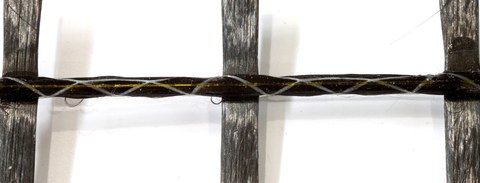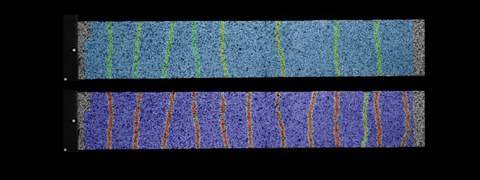Rules for structural design for non-metallic reinforcement
Table of contents
Project data
|
Titel | Title |
Report in the annual report 2023
Bond and deformation of carbon-reinforced concrete strengthening layers

Application of a fiber-optic sensor on a single carbon yarn
Strengthening of reinforced concrete structures with the composite material carbon-reinforced concrete offers a very efficient and economical alternative to the usual shotcrete or lamella methods. High-strength textile grids made from carbon fibers impregnated with a polymer are embedded in a layer of concrete just a few centimeters thick. This is a resource-efficient way of strengthening components with a particularly low material input, significantly increasing the service life of load-bearing structures in the long term.
Intensive research in recent years has made this innovative building material ready for practical use. Verification methods for the ultimate limit state have been established, based on known formulations of the established reinforcement methods. However, cracking, deformation or stress considerations are also relevant for the normal use of structural members. These must also be estimated in advance during the design process. In the joint project, the Institute of Concrete Structures of the TUD Dresden University of Technology is therefore researching the necessary design methods.
The bond between the reinforcement and the concrete, and therefore the interaction between these individual components, is critical to the structural performance of the whole structure. Tensile and bond tests were therefore carried out on defined material combinations as part of the investigations. In order to study not only the failure state but also the entire load-dependent behavior, the deformation and the associated crack formation were recorded using digital image correlation. In addition, distributed fiber optic sensors provided a view into the specimen to continuously record the strain in the reinforcement and concrete over time and along the measuring length. This allows conclusions to be drawn about the stresses and behavior of the composite. The next step is to verify the results on large components built to reflect the reality of the existing structure.
Report in the annual report 2022
Serviceability of carbon-reinforced concrete

Recording of crack development on a carbon-reinforced concrete tensile specimen with a photogrammetric measuring system
The pioneering extension of solid construction by concrete with non-metallic carbon reinforcement opens up a wide range of possibilities for structural engineering as well as for architecture that represent both innovations and adaptations of familiar construction methods. The further development of the innovative composite material carbon-reinforced concrete also forms an important basis for improving the sustainability and durability of cement-bound building structures. With slim and thin new building components, material can be saved and resource efficiency improved. In addition, when building in existing structures, a significant extension of the service life of load-bearing structures can be achieved by strengthening them with carbon-reinforced concrete. This is associated with a large CO2 savings potential.
To enable the applicability of carbon-reinforced concrete under German building law, components or reinforcements must be designed in accordance with the recognized rules of technology. These are currently not yet available for carbon-reinforced concrete, so that approvals in individual cases or general building approvals are required. However, it is not sufficient simply to ensure the safety of a structure with the absorption of all loads that occur. Equally, the proper use of the structure must be ensured under service conditions. However, there is a lack of generally applicable calculation models and information on the structural design, especially for the serviceability limit state (SLS). The CRC-BoDeM joint project is therefore developing rules for limiting crack widths, deformations and stresses, as well as verification methods for overlap joints and for anchoring non-metallic longitudinal bending and shear reinforcement. The analysis of the bond between the non-metallic reinforcement and the concrete is of particular importance.
The joint project is intended to help eliminate the market entry barrier for carbon-reinforced concrete to a large extent. We in Dresden will look specifically at the strengthening of existing reinforced concrete structures with carbon-reinforced concrete. The knowledge gained will be incorporated into practical regulations for the construction method so that the technological maturity of the innovation that is carbon-reinforced concrete is raised.
